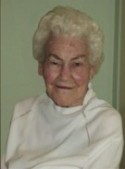Gladys C. Lester Dull’s extraordinary life began in the harshest of North Dakotan winters.
Gladys lost her parents during a flu epidemic in 1920, at just three years old. She was adopted by neighbours, and went away to live in a farming community.
Before her diagnosis, Gladys remembers feeling sick all the time, and the constant need to urinate. Finally, she made the nine-mile trip from her home in the farming community to the nearest doctor, where she was promptly diagnosed with type 1 diabetes. But type 1 diabetes was an obscure disease, rarely talked about, and her doctor didn’t know how to treat it.
Instead, he recommended that Gladys visit the Mayo Clinic in Rochester, Minnesota, a journey of more than 300 miles. Upon arrival, Gladys was admitted to hospital, to be treated with newly-developed insulin treatment.
Injecting yourself with insulin could, in those days, feel more like jabbing yourself with a knitting needle. Gladys recalls her early injections without fondness:
“I remember the first shot I got and being scared of it. The needles back then were a lot more painful than they are now – and a lot more expensive.”
If injections were unpleasant, the day to day management of type 1 diabetes was near enough impossible. This was a time without any technology to monitor blood glucose levels. Managing a diabetes-appropriate diet involved rough estimates at best.
But Gladys and her family were determined. Her mother went to diabetes education classes at the Mayo Clinic, where she was taught how to weight was figures that represented the weight of certain foods. Armed with this knowledge, she weighed all of her daughter’s food, giving Gladys “one gram more than what I was supposed to have.” While her grandfather used to buy her a piece of candy on his weekly trip into town, this quickly had to be replaced with a newspaper (for the comics).
Gladys got married during World War II. Her new husband, George, fought in the War, and for two and a half years they were separated while he was stationed overseas. Once reunited, they moved to Washington, where Gladys worked part-time in a portrait studio for 30 years.
Back when Gladys was first diagnosed, it was rare for a woman with type 1 diabetes to have be able to have children. But at the age of 30 Gladys gave birth to Norm Dull, her only child. Her daughter lives in a nearby town.
Sadly, Gladys’s husband George died in 2002, after 59 years of love and support. Gladys has also outlived all of her siblings: two brothers, two sisters; two older, two younger. None of them had diabetes. Her sister, however, did die from Alzheimer’s disease, which Gladys considers a far worse condition: “After seeing what my sister went through, I would much rather be a diabetic than have Alzheimer’s.”
Like most people who live for a long time with type 1 diabetes, Gladys doesn’t really have a trick. She just sticks to a good diet and gets plenty of exercise: “When I was younger, I did everything – horseback riding, cycling, snowmobiling, motorcycle riding – I always stayed active.” She maintains a healthy diet based on her mother’s food-weighing exploits, claiming that she can still judge roughly how much a portion of food weighs just by looking at it.
Glayds’s story is a wonderful testament to possibility, a tale that demonstrates people with diabetes can still achieve remarkable things. Gladys has never missed an insulin injection – “I’ve have never missed a shot in all these years, to date I’ve had over 60,000 of them” – all while surviving the Second World War, dealing with the grief of her parents’ death, getting married and bearing children. She has loved and she has lost, and through it all, her blood glucose has been under control.
Image source: diabeteshealth.com
Information adapted from mayoclinic.org and diabeteshealth.com



